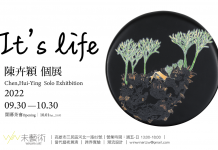「可見之誤,不可見之勿」這命題意旨攝影家耀斌這些年在攝影創作中,自我開啟的攝影觀念與作品之間的延續。「可見之誤」,所言即是攝影作為一種驗證式體驗,就在場的視角間,影像真確所要表達的並非再現真實,而是再現攝影者介入世界的方式;「不可見之勿」,所言即是在三系列作品中,以女性作為一種母性與記憶的回歸,轉而以一種社會化窺視投向身體隱喻的慾望存在事實。照片的不可見性,表示的是每一張影像在事物面前完全透明,它所呼應的是攝影者所介入意義本身,即使是再現,在數位化的當代影像中所表明的是作者意念的拼貼。
耀斌的攝影作品再現本質超越了所見的真實,並以一種不可見的姿態展現其對於影像主題掌握的特質,在編導與矯飾之間擺盪,作為呼應當代藝術的性格與不可違逆之宿命。此次展出特別從藝術家作品中挑選三項系列〈似花非花〉、〈罔市&招弟〉、〈藏著並不代表遺忘〉作品作為展出,系列作品有著藝術家以影像作為開啟自身與作品存在的關係的開展脈絡。
親情啟程到性別的觀看,一直是作品中最為核心的探索精神。耀斌攝影中所表達的與其說是直觀的性別與慾望的現象所直視之審美意識,作品卻很巧妙的運用著深具文化意涵的符號語言置入影像的隱喻,在看似直觀與現實之間擺盪,看似唯美又充滿著潛意識慾望主體在女性作為一種母性的依附與依賴的雙戀性。如攝影者在其創作論文所寫:他想藉由影像語言來闡述自己的想法跟概念……真實世界必須戴上面具應付職場,了解與眼見並不盡然。
羅蘭.巴特(Roland Barthes)曾揭示,視覺是所有知覺最神秘化的,與知覺完全不同,因為視覺具有著魔力。從一個專業藥師的職業跨越到攝影家的角色,從經歷母親離去的過程思索母性的性別依附,他以作品檢視自己的成長與記憶,並在攝影的世界中建構屬於他詮釋一種拉康(Jacques Lacan)所言的匱乏感(Lack)。在看似可見的影像表徵外建構了看與被看的矛盾,就此展示著觀者所看見作品同時也是看見自己內心的瞬間。
個人欣賞耀斌的攝影作品,不僅僅因為他對情感表述的再現能力,更是他藉由觀景窗看見事物的力量,在看不見的意識當下依然以自己的影像讓觀者觸摸其記憶溫度與觀看的感知。
The title Behind the Image signifies an innovative concept and its continuation throughout Liu Yao-bin’s work over these years as a photographer. It suggests the misconception of visibility in the core of photography, as a confirmatory experience to a present viewer, the authenticity of image does not suggest representation of reality but the way which the photographer interferes in the world of reality. The title also suggests an invisibility, which responds to the reoccurring motif of female as maternity and primitive memory, and thus implies the existential truth of a desire behind the symbol of female body through a sophisticated glimpse. The invisibility of image refers to total transparency of every image at the presence of its subject, it echoes the photographer’s interference to meaning, although coming across a representation, the contemporary digital images demonstrate a pastiche of the mind of its creator.
The representative characteristic in Liu’s photographic work surpasses the visible reality, presenting his grasp in image themes with an invisible posture; as a response to contemporary art feature and its irreversible destiny, these works stand on the edge between producing and feigning. The 3 series In Bloom, Not a Flower, Bóng-tshī and Zhao Di, Hiding is no Equal to Forgetting are selected on display in this exhibition, for a series of work contains the developing context of how the artist created a connection between art pieces and himself in the images. The gaze upon affection and gender has always been the core essence of exploration in his works. Rather than merely an aesthetic judgement in the perspective of direct phenomenon of sex and desire, his photography skillfully applies a visual language with profound cultural meanings in his allegories of image; it wanders between the realm of intuition and of reality, in it exists a dual-affection of a subconscious subject with desire on female as a kind of maternal attachment and dependance, albeit dreamy. As the photographer wrote in his artist statement: he wishes to elaborate his own ideas and concepts via a language of images… for one must wear his mask and cope with his workplace in the world of reality, while seeing is not equivalent to understanding.
As Roland Barthes proclaimed, vision is the most mysterious among all senses, it is on the other side of the spectrum from knowledge, because magic lies within vision. Liu transferred from the career path of being a professional pharmacist to the role of a photographer, and having been through losing his mother he begun to ponder the sexual attachment of maternity. He reviews his personal history and memory through creative process, and thus constructs this kind of Lacanian lack of his own interpretation in the world of photography. Hence he constructed a paradox of seeing and being seen through the seemingly in sight character of image, and thus demonstrates that the moment a viewer sees an art piece, they see their inner truth.
I see value in Liu’s photography, not only for his representative ability in emotional expressions, but also for his capability to see things via a viewfinder, allowing viewers to connect with the truth of his memory and the perception of seeing through his image creation while being aware of the invisibility character of photography himself.
原文:https://artemperor.tw/tidbits/12219







